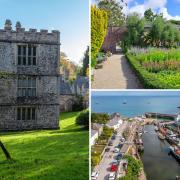It’s a stunning part of Cornwall that’s perfect for getting away from it all. Abby Driver heads to the Rame Peninsula
It’s known as Cornwall’s forgotten corner, yet despite the depressing nickname The Rame Peninsula has a lot going for it. It’s an area of outstanding natural beauty boasting quiet beaches, glorious views along the south west coast path and a smattering of quaint villages.
Forget Me Not
The Rame Peninsula is fairly isolated compared to the rest of the county; it’s more than 50 miles away from the Cornish capital of Truro. It’s also isolated by virtue of being a peninsula – it’s surrounded by the English Channel, the River Tamar and the River Lynher.
The Rame Peninsula is so close to the Devon border, visitors tend to skim straight past it on their way down to more well-known tourist hot-spots such as Padstow, Rock and St Ives. And in fact, a chunk of the Rame Peninsula was part of Devon up until a boundary reform in the 19th century.
Claim to Fame
John Pollard RN, the man with the rather grand title of Nelson’s Avenger’, was a former resident of Kingsand. A commander in the Navy, he served under Nelson and is credited with shooting the French sailor who killed the Admiral. Some even say Nelson himself has visited the village and dined at the – now closed – Ship Inn.
Another sea-based celebrity resident was Ann Davison. In 1953, at the age of 39, she became the first woman to sail the Atlantic single-handedly. You can read her autobiography My Ship Is So Small for a full account of her incredible adventure.
And if you’ve watched Mr Turner, Mike Leigh’s biopic of the eccentric artist JMW Turner, you will have spotted the Rame Peninsula - albeit in disguise: Kingsand stars as a 19th century Margate.
Village life
One of the most popular areas of The Rame Peninsula is the twinned seafront villages of Kingsand and Cawsand, with their tiny, hilly streets and colourful fishermen’s cottages overlooking Plymouth Sound.
Back in the day, village life revolved around fishing. From the shoreline you can make out the remains of old pilchard cellars from the late 16th century, just beyond Kingsand. Known as Pilchards Palaces they were used for housing and handling this prized catch. Like much of Cornwall, smuggling was rife on the Rame Peninsula in the 1700s and 1800s and the villages were centre-stage of the action. It is said that more than 50 smuggling boats operated out of Cawsand Bay with thousands of casks of spirits being landed each year - the smuggling days are over and instead today you’ll find a bright seaside village with beautiful beaches, decent pubs and quaint art galleries.
A Work of Art
If art’s got your heart, Makers Heights in Rame is the place for you. With its natural beauty and fantastic light and old Napoleonic barracks used as studios, it’s not surprising that it has inspired many artists who have become collectively known as the Rame School of Art. Swing by The Somerville Gallery in Makers Height, it’s a stunning space which showcases established well-known artists alongside those working in the studios.
Feeling crafty? Venture further inland to the village of Millbrook and check out The Byre; it’s a contemporary craft gallery which showcases work in ceramics, glass, jewellery, metals and textures. It also regularly hosts exhibitions; the next one, Pastures New, runs from 2 April – 5 June and will feature some brand new makers.
In Kingsand you’ll find The Panache Gallery, a family-run gallery that stocks a range of original art, prints and jewellery. They sell originals by Plymouth-based Brian Pollard, whose colourful paintings would serve as a beautiful reminder of your holidays. You’ll also find impressive limited edition bronze sculptures by Denise Dutton. A modern exhibition space for local artists, The Westcroft Gallery in Kingsand is also well worth a visit.
Grand Tour
Port Eliot House and Estate is believed to be the oldest continually inhabited dwelling in the UK. The earliest physical remains are a tiled floor, around 1,500 years old, which dates from the 3rd and 4th century during the late Iron Age. The earliest written reference to Port Eliot is in a 9th-century Cornish liturgical fragment which refers to Ecclesia Lnanledensia - its pre-Christian name. Despite the age of the house, the roof – which covers half an acre – has not once in living memory been completely watertight! The surrounding gardens are glorious and spring is a great time to explore the thousands of daffodils and beautiful camellia glade.
An early 18th-century mansion, Antony House and Gardens should definitely be on your To Do List if you’re in the area. Overlooking the Lynher River, the imposing house was built for Sir William Carew between 1711-1721. Inside there is an outstanding collection of portraits, including works by Sir Joshua Reynolds and a famous painting of Charles I during his trial. Antony was also Tim Burton’s choice for shooting his blockbuster Alice in Wonderland – the perfect pocket sized mansion.
Mount Edgcumbe House and Country Park - first built in the 1500s and restored after World War Two - is set in a beautiful landscaped park with fallow deer, woodland and coastal walks. There are more than 865 acres of parkland to explore and, if you’re totally taken in by the charm of the place, you can even stay on-site in one of two holiday lets.
Good natured
The centrepiece of the village of Millbrook is a huge lake of 4.5 acres. It provides a fantastic habitat for wetland birds and, as a result, is a very fruitful spot for birdwatching. Bring your binoculars and be on the lookout for egrets, herons and avocets.
Into rare plant species? Head to Eglarooze Cliff. The south-facing cliff, west of Portwrinkle, has been labelled a Site of Special Interest as it contains two endangered plant species: the slender bird’s-foot trefoil (Lotus angustissimus) and carrot broomrape (Orobanche maritima). The butterfly species including grayling (Hipparchia Semele) and dark green fritillary (Argynnis aglaja), both of which are nationally declining species, have also been spotted around Eglarooze Cliff.
And, of course, this section of Cornwall makes for fantastic walking along the South West Coast Path. Take the path from Cremyll to Kingsand; it’s a little over three miles and will take you around 1.5 hours. Youll go through Mount Edgcumbe Country Park, around the middle prong of the peninsula where you can revel in the views of Plymouth Sound and finish up in the sweet village of Kingsand where – most importantly - tasty refreshments are aplenty.
A bite to eat
For inspired seafood with stunning ocean vistas, you need to book a table at The View restaurant. Plonked atop the cliffs above Whitsand Bay, the view is near perfect, much like the locally sourced seafood menu. For classic pub nosh with a French twist, head to The Devonport Inn in Kingsand. Unlike traditional pubs, The Devonport Inn feels airy and breezy, helped along no doubt by the view across Kingsand Bay. After something a bit lighter? The Old Bakery in Cawsand brews a fine cup of Joe and the cakes are divine.
When to Go
The Rame Peninsula is the place to be on the May Day bank holiday. The Flower Boat ritual has been carried out in Millbrook since the 14th century and is still going to this day. It starts off in the mid-morning with a procession of dancers and singers carrying a boat decorated with spring flowers though Millbrook, Kingsand and Cawsand. In the evening the boat is launched into the water accompanied by a firework display.
From the 28–31 July you can call Port Eliot home and camp at the annual bohemian festival of music, literature and culture. Camping not your jam? Stay in an on-site converted Airstream trailer, fitted with iPod connector, shower and – goodbye bad back – a proper bed! w


























